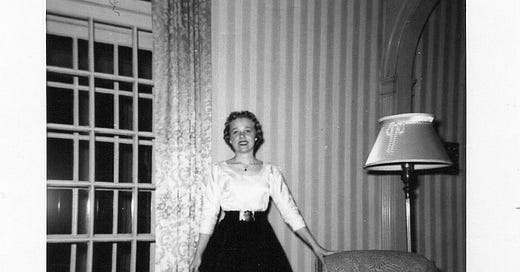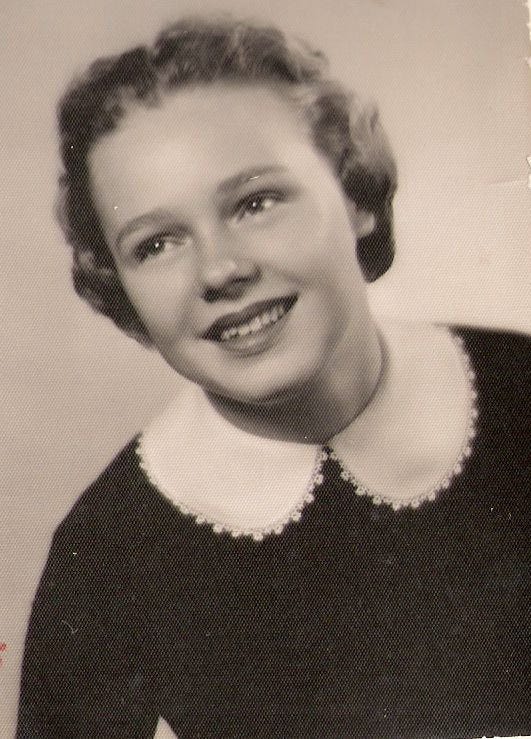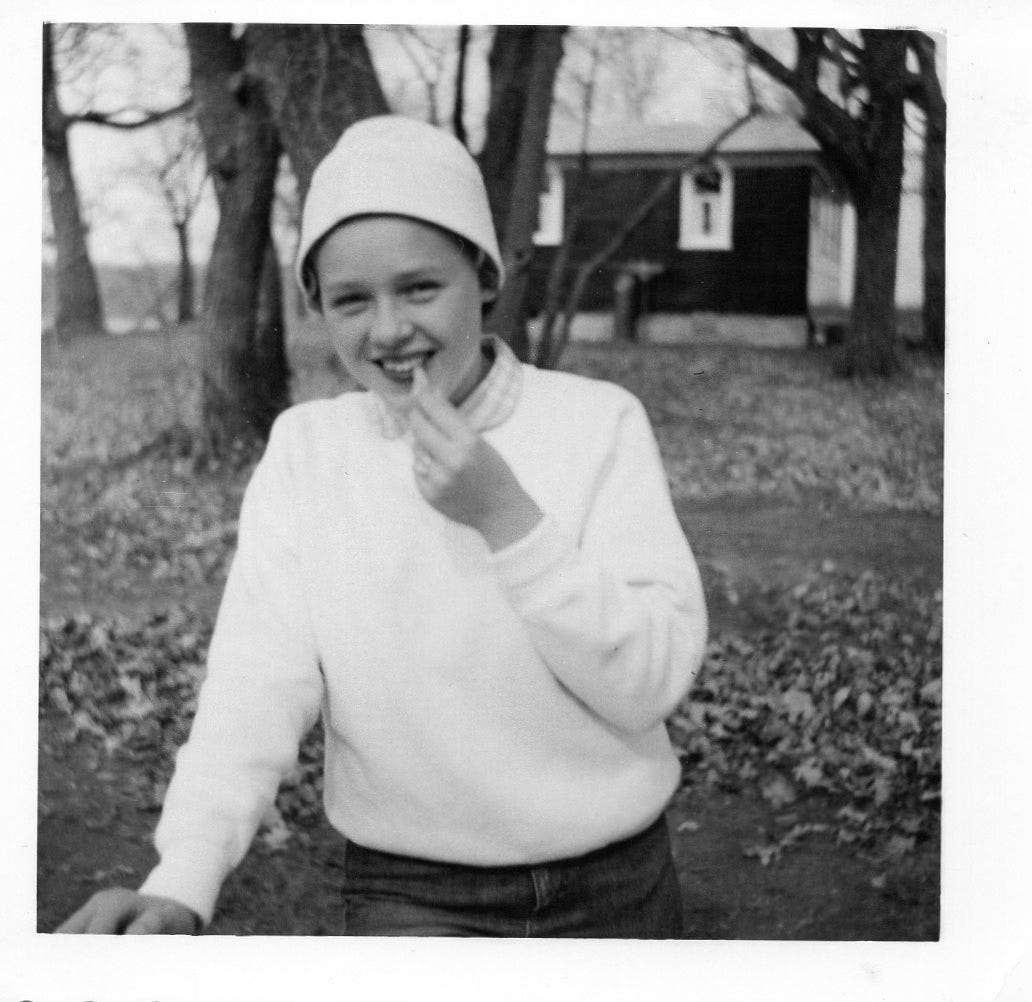Remembering Mom and the foods she loved
A few of my mom's favorite recipes and the stories around them
Release Date: May 8, 2025
Remembering Mom
My mom, Renola Semerau Wegner, was born in 1937, the only child of Howard Semerau and his wife — and the love of his life, Elvira Stelljes Semerau. Their’s was a love affair that resonates in my life and the lives of their grandchildren and great grandchildren to this day.
My grandparents waited four long years for Mom’s birth, and when she arrived, at least according to family stories, they were over the moon. To say Mom grew up equal parts loved and spoiled is undisputed.
When Mom was six, Grandpa enlisted in the US Navy to fight the Japanese. At age 36, he spent the next 20 months at sea, leaving Grandma and Mom at home. Mom rarely talked about that time — none of them spoke of it. But, on those rare occasions when she did, there was a sense of simmering resentment and unforgiveness. Her father’s absence subtly removed her from the center of the world, and Mom was not happy about it.
Still, she went on to be Homecoming royalty and the envy of her classmates. And that was enough.
In 1957, Mom and some girlfriends were out at the Semerau lake house when they witnessed a young man struggling in the water. Mom hopped in the motor boat and, according to legend, rescued the man who would become her husband and my father, Adrian Wegner.
They were married in 1958 and parents to my sister and me by 1962.
It’s hard for a child to know their parents as anything beyond a parent. Our view is so myopic, so self-centered, so linear. Plus, what do we know of adulthood? Of the pressures and stress, the inner-workings of relationships, of responsibilities? Of unfulfilled dreams?
I do know I loved Mom. And she loved me.
And I know that, since her passing in 2013, I’ve come to understand her in ways big and small. And to better understand myself as her daughter.
That, too, is enough.
Happy Mother’s Day in heaven, Mom.
Minnesota’s own, Glorified Rice
My home state of Minnesota is famous for a lot of things:
Vikings, for example, the football ones but also the real ones.
Lakes — we have 11,842 of them, if anyone is counting. And btw, our lakes are real lakes, 10 acres or more, Anything less is a pond, a pothole or a decorative water feature, no matter what my Texas-born husband might believe.
Duck, Duck, Grey Duck. And yes, that’s the only acceptable name for the children’s game which involves one child walking around a circle of their peers saying, “duck, duck, red duck”, “duck, duck, blue duck” and finally, ultimately “duck, duck, GREY duck!” which prompts the sitting child to rise up excitedly and chase the first child around the circle while the entire room erupts in laughter.
Another thing Minnesota is famous for, or at least should be famous for, is glorified rice.
My mom sure was.
It was her go-to dish. Mom brought glorified rice to funerals, family reunions and neighborhood potlucks. She served it at Easter and birthdays and every year for Mother’s Day.
If you’re unfamiliar with this classic Minnesota dish — first off, I’m sorry. And secondly, I’ll do my best to describe it.
You start with rice. Mom’s choice was instant rice, but old-fashioned rice works just as well as long as it retains the necessary starch artifacts. Yeah, you heard that right.
Next you toss in some crushed pineapples, canned, of course. Then another can, this one fruit cocktail.
Chop up a banana. One not ripe enough to make banana bread out of, but not green, either. Fold that in with your grandma’s rubber spatula.
Grab a bag of miniature marshmallows and toss them in.
And then, because this is a true Minnesota delight, add that container of Cool Whip.
There are a couple other ingredients, but we’ve got the basics. Easy peasy.
In terms of flavor, texture and mouth feel, however, things get a wee bit more complex.
Think cloyingly sweet, and mushy but with the starchy gelatin-like squishiness of over-cooked white rice, in unison with the shocking brightness of pineapple bits and the occasional hint of a well-preserved maraschino cherry.
What’s not to love!
Food historians suggest the popularity of glorified rice in Minnesota — its all but unknown elsewhere — might be attributed to the state’s large Scandinavian population, a group of folks who celebrate the flavor and texture of lutefisk, rehydrated dried cod which has been soaked in lye. For the uninitiated — bless your heart, btw — this Christmas classic and the culinary foundation of church suppers across the state, can best be described as having a “slightly gelatinous texture and mild fishy taste.”
Makes glorified rice sound downright delectable, right?
Probably because I grew up with it and didn’t know any better, I spent most of my teen years, if not looking forward to finding glorified rice on the Mother’s Day buffet, at least not dreading it.
It could also be because glorified rice was a staple of elementary school lunches which seem to have a cult-like hold on me to this day.
As for why my German-heritage mother became so enamored with this decidedly not-German dessert, I have no idea.
She did love cooking out of cans. But then again, maybe it was the Cool Whip!
For more insight into glorified rice, as well as other Minnesota cultural touchstones, check out They Glorified Mary...We Glorified Rice: A Catholic-Lutheran Lexicon by Minnesota’s own Janet Letnes Martin and Suzann Nelson. It is both hilarious and spot on.
Finding the “good stuff”
The morning of the day I went into labor with my firstborn, Mom called and asked if I wanted to go out to lunch. I was staring down the barrel of week 43 and I was enormous. My ankles were so swollen I could only wear velcro slippers, and I’d been on modified bed rest for five weeks. Mom could have offered to take me to a a frozen outdoor pig trough and I would have jumped on it.
When she suggested we meet at the “good” Chinese buffet in town, however, I admit to hesitating.
Let’s just say Mom’s idea of “good” Chinese food was a bit different than my own: She loved Asian-inspired — it says that right on the label — La Choy products, I preferred something a little more authentic, and a whole lot less…slimy.
Of course, it stemmed from my childhood, where canned chicken chow mein over crunchy chow mein noodles was a “fancy” meal, at least according to Mom.
I don’t blame her. Really, I don’t. Although the first Chinese restaurant in Minnesota had opened in 1883, — it was named Yuen Faung Low, but known locally as “John’s Place” — Asian food was just not something found on many rural Minnesota tables.
Especially on tables belonging to meat-potato-and-vegetable-loving German Minnesotans like my Semerau family.
So, when the Chinese food craze hit our little part of the world — likely about the same time President Nixon came back from his visit to China with Ling-Ling and Hsing-Hsing — Mom jumped on board the best way she knew how: with something in a can.
In the end, Mom and I did have lunch at the local Chinese place, and, as I recall it was pretty good. I had some beef and broccoli, and Mom filled her plate with a little bit of everything. We talked some about how I was feeling, and I remember Mom sharing some memories of when she was pregnant with me, something we’d never talked about before.
It was nice.
It’s still a nice memory.
The next day, newborn at my breast, Mom walked into the hospital room with a huge smile on her face. Her plan had worked, she said. She knew Chinese food would get her first grandchild to come out and say hi.
That time Mom fell in love with Marie
One of the dishes Mom really came to love in her later life, especially after Dad passed away and she was on her own, was chicken pot pie. I don’t remember her ever making one from scratch — although way back in my food memory bank I seem to recall eating Banquet frozen chicken pot pies while watching The Wonderful World of Disney as a child — but I do know that, in last decade of her life, nearly every time I came to visit and offered to bring Mom out to dinner, she ordered a chicken pot pie.
I’d usually get her two, one to eat in and one to take home and enjoy later.
Maybe because of the low bar set by those early frozen versions, Mom was happy with just about any chicken pot pie we could find. For a time, KFC’s version was her favorite.
Then I introduced her to Marie Callender.
Well, not the woman. The brand. And it was love at first bite.
For the rest of her life — no matter where in the world I was — I sent Mom regular deliveries of Marie Callender frozen chicken pot pies.
I’d do anything to send her a few today.
Copyright 2025 Lori Olson White
Renola’s Glorified Rice
Ingredients:
1 9-oz can crushed pineapples
2/3 cup packed precooked rice
2/3 cup water
1/2 teaspoon salt
1 1/2 cups miniature marshmallows
1 fully ripe banana, diced
1 can fruit cocktail
2 tsp lemon juice
1 cup Cool Whip
1 tablespoon sugar (option)
Instructions:
Drain pineapple, reserve syrup.
In saucepan, combine rice, water, ,syrup and salt. Mix to just moisten rice. Bring quickly to boil, cover and simmer for 5 minutes.
Remove from heat. Let stand 5 minutes.
Add marshmallows, pineapple, banana and juices.
fold in Cool Whip then chill. 1
Mary Martensen’s Chicken Chow Mein
Ingredients:
1 1/2 cups diced cooked chicken
3 tablespoons salad oil
1 medium onion, thinly sliced
2 cups diced celery
1 cup diced green pepper
1 cup water
1/2 teaspoon salt
6 tablespoons soy sauce
2 tablespoons cornstarch
1/4 cup water
1 cip sliced mushrooms
1/2 cup slivered almonds
Instructions:
Heat oil in a heavy saucepan, add onion and cook and stir until yellow. Then add chicken, celery, green pepper, salt, water and soy sauce, and cook for about 5 minutes, or until the celery and pepper are crispy stender.
In the meantime, been corn starch and 1/4 cup cold water, add to the mixture and cook and stir until thickened.
Add mudrooms, mix well, and serve with crisp noodles and a garnish of slivered blanched almonds. 2
My favorite Southern Living chicken pot pie
Ingredients:
1/2 cup butter
1/2 cup all-purpose flour
1 1/2 cups chicken broth
1 1/2 cups half-and-half
3/4 teaspoon salt
1/2 teaspoon coarse ground black pepper
8 oz sliced mushrooms
1 small onion, chopped
1 cup frozen green peas
3 1/2 cups chopped, cooked chicken
2 hard boiled eggs, chopped
1 (15 oz) package of refrigerated pie crusts
1 Tablespoon whipping cream
1 large egg, slightly beaten
Instructions:
Melt 1/2 cup butter in heavy saucepan over low heat; whisk in flour, whisking until smooth. Cook, whisking constantly, 1 minute. Gradually add chicken broth and half-and-half; cook over medium heat, stirring constantly until thickened and bubbly. Stir in 3/4 teaspoon salt and 1//2 teaspoon pepper; set white sauce aside.
Melt 1 tablespoon butter in large skillet over medium-high heat; add mushrooms, season lightly with salt and pepper, and sauté 10 minutes or until nicely browned. Don’t overstep. Add mushrooms to white sauce. Add remaining 1 tablespoon of butter to skillet. Add onion; sauté until tender. Stir inputs. Add vegetable mixture, chicken, and chopped eggs to white sauce.
Preheat oven to 375 F. Fit 1 piecrust into a 9-inch deep dish pie plate according to package directions. Spoon filling into crust; top with remaining piecrust. Trim off excess pastry. Fold edges under, and flute. Cut slits in top/ Combine cream and off; brush egg wash over pastry.
Bake at 375 F for 30 to 40 minutes or until browned and bubbly. 3
Your turn and your culinary traditions
What dish instantly brings your mother to mind, and what do you remember about the first time you tasted it?
Describe the flavors, the setting, and any emotions that come up when you think of that moment.Was there a meal your mother made for special occasions, holidays, or when you needed comforting?
Did your mother have a “signature” recipe? Where did it come from, and how has it been passed down (or transformed) in your family?
What was your mother’s relationship with cooking? Did she enjoy it, see it as a duty, or use it as an expression of love, culture, or creativity?
Recall a kitchen scene from your childhood involving your mother. What sounds, smells, and textures filled the space? What were you doing while she cooked?
Have you ever tried to recreate one of your mother’s dishes? How did it go, and what did you learn—about the food and about her—through the process?
What foods did your mother make that reflect your family's heritage, region, or traditions?
What would you say to your mother today if you could thank her for one food memory?
MARK YOUR CALENDARS! Next Friday I’ll be sharing some fabulous reader-submitted potato salad stories and recipes in a little thing I’m calling “The Humble Potato Salad Book of Stories and Recipes.”
In case you missed it
If stories at the intersection of food and family history are what you’re looking for, look no further than our archives! Here are a few of our favorites.
Please hit the “like” button if you enjoyed this newsletter — it’s a little thing you can do to support my work!
Culinary History is Family History is reader-supported. When you buy through links on our site, we may earn an affiliate commission.
End Notes:
1 Renola Semerau Wegner’s recipe
2 Unattributed newspaper clipping in the Elvira Semerau recipe collection owned by Lori Olson White
2 Chicken Pot Pie, Southern Living Comfort Food: A Delicious Trip Down Memory Lane, Oxmore House, 2009. P. 29.











What a beautiful story about a wonderful mum! I love the story of how she met your dad, a real life hero. She would be so proud of you and everything you’ve achieved Lori
You describe a tradition of cooking that was closer to my grandmother's style than my mother's. In the 1960s, my mom 1) went on a holiday to France and 2) discovered Julia Child. For someone who grew up eating meatloaf, casserole, and other traditional 'American' foods, it was mind blowing. She apprenticed herself to Julia, The Galloping Gourmet, and Perla Meyer (her favorite!). I must say I did not appreciate this cooking as a child (I often preferred the cooking of other family and friends, which was heartier and plainer) but now I understand how much I absorbed about good food and cooking from what she learned. I think in the end, we all come to understand the love that goes into wanting to feed people, and feed them well.